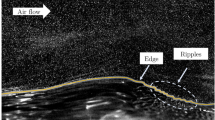Abstract
There are differences in the literature concerning the vertically dependent equations that couple currents and waves. In this paper, currents are purposely omitted until the end. Isolating waves from currents allows one to focus on two main topics: an explanation of Stokes drift with apparent mean vorticity obtained from an otherwise irrotational flow and the determination of vertically dependent wave radiation stress which, when vertically integrated, conforms to that obtained by Longuet-Higgins and Stewart (1964) and Phillips (1977) nearly 50 years ago and, more recently, by Smith (2006). Discussion begins with the simple case of nonlinear flow beneath a stationary wavy wall.






Similar content being viewed by others
References
Ardhuin F, Rascle N, Belibassakis KA (2008) Explicit wave-averaged primitive equations using a generalized Lagrangian mean. Ocean Modelling 20:35–60. doi:10.1016/j.ocemod.2007.07.001
Dean RG (1965) Stream function representation of nonlinear ocean waves. J Geophys Res 70:4561–4572
Mellor GL (2003) The three dimensional, current and surface wave equations. J Phys Oceanogr 33:1978–1989
Mellor GL (2008) The depth dependent current and wave interaction equations; a revision. J Phys Oceangr 38:2587–2596
Longuet-Higgins MS, Stewart RW (1964) Radiation stresses in water waves; a physical discussion with applications. Deep-Sea Res 11:529–562
McWilliams JC, Restrepo JM, Lane EM (2004) An asymptotic theory for the interaction of waves and currents in coastal waters. J Fluid Mech 511:135–178
Phillips OM (1977) The dynamics of the upper ocean. Cambridge University Press, Cambridge, p 336
Smith JA (2006) Wave–current interactions in finite depth. J Phys Oceanogr 36:1403–1419
Acknowledgment
The support of the Minerals Management Services under grant M09PC00006 is appreciated. Suggestions by reviewers were very helpful.
Author information
Authors and Affiliations
Corresponding author
Additional information
Responsible Editor: Leo Oey
This article is part of the Topical Collection on 2nd International Workshop on Modelling the Ocean 2010
Appendices
Appendix 1
1.1 Derivation of the Stokes drift
The conventional “Lagrangian” derivation of Stokes drift velocity is
After insertion of Eqs. 10a and 10b, one obtains
Another approach is to consider the flow through a fixed element bounded by z and z + Δz. The velocity is \( \tilde{u}(z) + \tilde{z}{(\partial \tilde{u}/\partial z)_z} \), and the wave distorted flow area relative to the undistorted area is \( 1 + {(\partial \tilde{z}/\partial z)_z} \); the product of the two terms after phase averaging is
Appendix 2
1.1 Alternate derivation of Eq. 17 following Phillips (1977)
Adjusting the origin of z so that \( \hat{\eta } = 0 \), the result of integrating Eq. 2b from arbitrary negative z to \( z = \tilde{\eta } \) is,
where \( p(\tilde{\eta }) = {p_{\rm{atm}}} \), i.e., the instantaneous pressure is continuous across the interface. Note that \( \tilde{w}(\eta ) = \partial \tilde{\eta }/\partial t + \tilde{u}(\tilde{\eta })\partial \tilde{\eta }/\partial x \) so that the second, fourth, and fifth terms on the left cancel. After phase averaging, \( \overline {\partial \int^{{\tilde{\eta }}} {\tilde{w}dz/\partial t} } = \overline {\partial \int^{{\tilde{\eta }}} {uwdz/\partial x} } = 0 \) leaving
Thus, whereas the instantaneous pressure is continuous across the air–sea interface at z = 0, the phase-averaged pressure is discontinuous.
Rights and permissions
About this article
Cite this article
Mellor, G. Wave radiation stress. Ocean Dynamics 61, 563–568 (2011). https://doi.org/10.1007/s10236-010-0359-2
Received:
Accepted:
Published:
Issue Date:
DOI: https://doi.org/10.1007/s10236-010-0359-2




